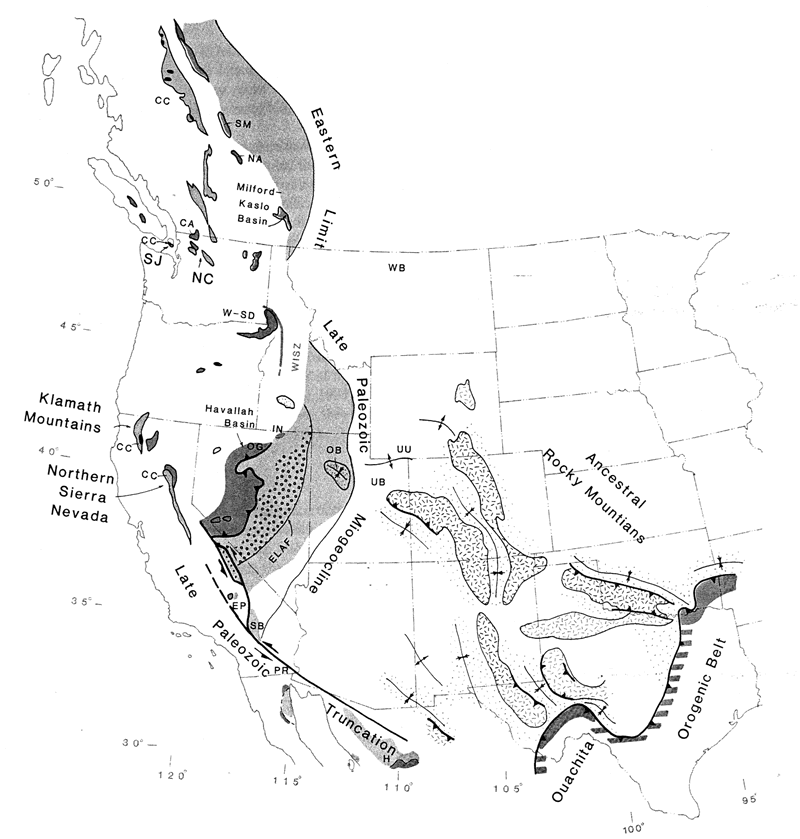Introduction
What were the Ancestral Rocky Mountains?
The Ancestral Rockies were a series of intracratonic basement uplifts and associated basins created during intense periods of deformation from the late Mississippian to early Permian (320 - 270 Ma). These ancient structures generally strike N-NW to S-SE and are most abundant in Colorado, New Mexico, Texas, and Oklahoma (Figure 1). During the late Paleozoic period, North America was much closer to the equator, and regional elevations in the vicinity of the Ancestral Rockies were much closer to sea level.

Figure 1 - Late Paleozoic paleogeography and tectonics of western North America, showing the intracratonic Ancestral Rocky Mountains (dashed pattern) in relation to contemporaneous structures and events. The Ouachita Orogenic Belt is dashed where present in the subsurface only. Other rock units include: ophiolites (black); miogeoclinal rocks (light gray); off-shelf rocks (dark gray); CA, Chilliwack arc; CC, Cache Creek assemblage; ELAF, eastern limit of Antler foredeep; EP, El Paso Mountains; H, Hermosillo; IN, Independence Mountains; NA, Nicola arc; NC, northern Cascade Mountains; OB, Oquirrh basin; OG, Osgood Mountains; PR, Peninsular Ranges; SB, San Bernadino Mountains; SJ, San Juan Islands; SM, Slide Mountain; UU Uinta uplift; UB, Uinta basin; WB, Williston basin; WISZ, future location of West Idaho suture zone; W-SD, Wallowa-Seven Devils arc. From Burchfiel, Lipman and Zoback, 1992).
How do we know they existed?
The Ancestral Rocky Mountains have long since eroded away, but evidence of their former presence can be interpreted from basin stratigraphy, isopach patterns, sedimentation rates, unconformities, and offset stratigraphic units. Many of the Ancestral Rocky structures in Colorado and New Mexico have been overprinted by later deformation during the Laramide Orogeny or the formation of the Rio Grande Rift, further complicating their identification and interpretation.
Why did the Ancestral Rockies form in the middle of the continent?
Here we arrive at the BIG QUESTION facing geologists who are trying to understand the Paleozoic history of the western United States. Usually mountain belts are located where deformation is concentrated along plate margins, where compressional stresses are working against gravity to drive rock uplift. But the Ancestral Rockies formed in the middle of the North American plate, 1500 km away from any active plate boundary! Their intraplate setting, along with their structural descendants, the Modern Rocky Mountains, are thus a puzzle begging to be solved by earth scientists. An unsolved puzzle is bound to have a variety of proposed solutions, and that is exactly what decades of study have produced regarding the origins of the Ancestral Rockies:
OUACHITA-MARATHON OROGENY: Many researchers
(see, for example, Kluth and Coney, 1981; Kluth, 1986; Burchfiel et al.,
1992) have cited concurrent deformational events along the eastern and
southern margins of North America as an explanation for the rise of the
Ancestral Rockies. The collision of South America and Africa with North
America during the Pennsylvanian period (310 - 280 Ma) is widely accepted
as the final suturing event that formed the supercontinent Pangea. Along
North America's eastern margin, this collision is known as the Alleghenian
orogeny, which put the final deformational touches on the Appalachian
Mountains. Along the southern margin of North America, the Ouachita-Marathon
orogeny created a similar chain of folded mountains, now largely eroded
away and buried in sediment. Progressive suturing of South America-Africa
with North America would have directed compressional stress in a N-NW
direction, and the Ancestral Rocky uplifts were possibly a response to
distributed stress within the foreland of this continental collision.
WICHITA MEGASHEAR: Another hypothesis (Budnik, 1986) gives structural evidence of left-lateral strike-slip motion along the NW-SE-trending Wichita Megashear that extends from Oklahoma to Utah. This pre-existing zone of weakness could have been reactivated by the collision between eastern North America and Africa (the Alleghenian orogeny), translating stresses well into the interior of the continent to uplift the Ancestral Rockies.
SUBDUCTION: Igneous rocks in northeastern Mexico have been cited as evidence of a late Paleozoic volcanic arc in the region southwest of the Ancestral Rocky structures (Handschy, Keller, and Smith, 1987; McKee, Jones, and Anderson, 1988; Ye et al., 1996). Arc volcanism implies subduction, so it is argued that a northeast-dipping subduction boundary formed the southwestern margin of North America during the late Paleozoic. Deformation of the Ancestral Rockies was thus driven by NE-directed compressional forces from this subduction zone.
TRANSTENSION: A final hypothesis presented here involves forces along the western margin of North America during the late Paleozoic. Evidence of a transform boundary along the western edge of the continent, along with east-west extension driven by this transform boundary, is used to support the idea that the Ancestral Rockies formed from a combination of stresses acting upon the mid-continent (Sevenson and Baars, 1986; Johnson, Chan, and Konopka, 1991).
Why are they important to us today?
The deformation of the Ancestral Rocky Mountains produced structures that have yielded huge amounts of oil and gas in the mid-continent. Basins that trapped sediment that eroded off the Ancestral Rocky Mountain uplifts also enclosed the biochemical catalysts for hydrocarbon creation, along with prodigious amounts of evaporites which dome upwards through time and form excellent traps for oil and gas. The folded and faulted nature of the Ancestral Rocky structures are also ideal sites for the accumulation of hydrocarbons. Areas deformed by the Ancestral Rockies have been among the most economically productive regions in North America, but the search continues for more reserves. Mechanisms of ancient deformation may determine where oil and gas are now trapped, so the controversy over origins is important where the Ancestral Rocky Mountains once stood.
Uplift of the Ancestral Rockies is also an enigma of plate tectonic theory, so a better understanding of intraplate deformation, reactivation of older structures, and global reconstructions of plate configurations through time can be gained through continued investigation of the Ancestral Rockies.
